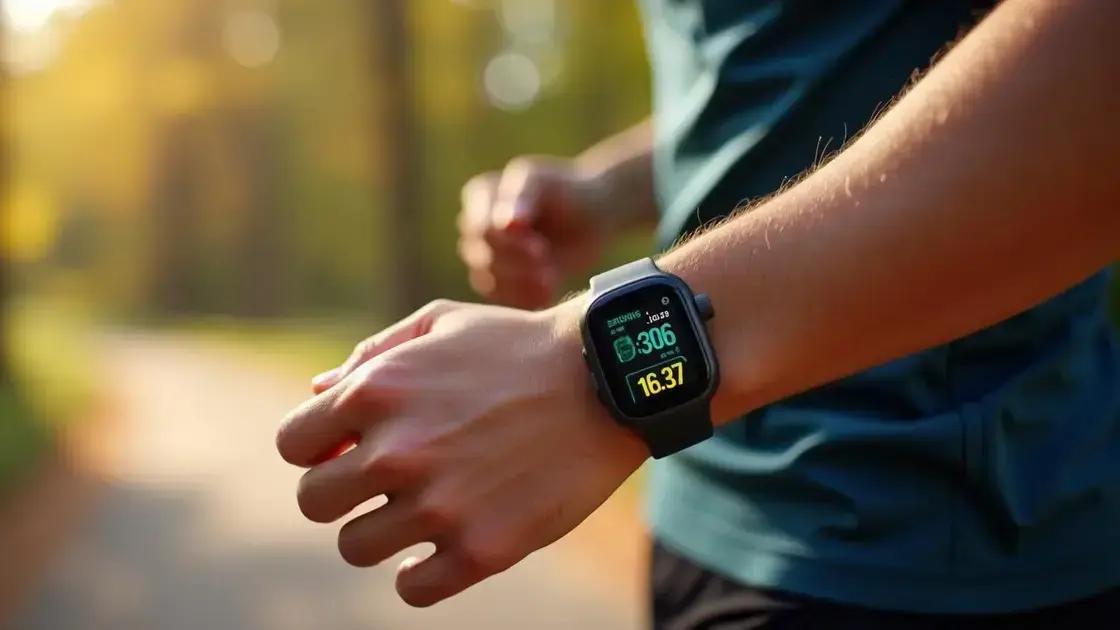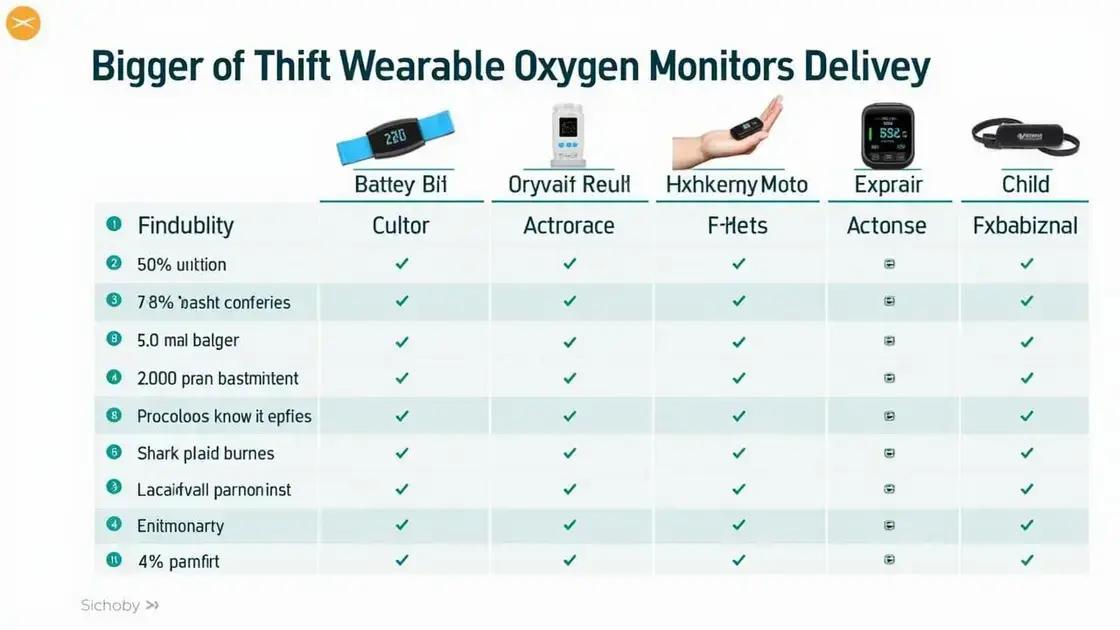Wearable oxygen monitors are essential devices for endurance athletes, providing real-time insights into oxygen levels to enhance training, improve performance, and prevent injuries through data-driven decisions.
Wearable oxygen monitors have gained immense popularity among athletes looking to improve their endurance training. These innovative devices provide real-time insights into oxygen levels, helping fitness enthusiasts optimize their performance. In this article, we will discuss the growing significance of these monitors, explore their benefits for endurance athletes, and guide you on selecting the right one for your training needs. Join us as we delve into the future of wearable technology.
Understanding Wearable Oxygen Monitors

Wearable oxygen monitors are devices designed to measure the level of oxygen in a person’s blood in real-time. These gadgets have become increasingly popular, especially among athletes aiming to boost their endurance training. By providing accurate data on oxygen saturation, these monitors help users understand how well their body is utilizing oxygen during physical activity.
How Do They Work?
Most wearable oxygen monitors work using a technology called pulse oximetry. This method uses light sensors to assess the color of blood as it flows through the skin. Oxygen-rich blood is bright red, while oxygen-poor blood is darker. The device calculates the percentage of oxygen in the blood and displays the results instantly on a screen.
Key Features to Look For
When shopping for a wearable oxygen monitor, it is important to consider features like accuracy, battery life, and comfort. A reliable device will provide precise measurements and have a long-lasting battery to support extended training sessions. Additionally, a comfortable fit is essential, as athletes will often wear these monitors during rigorous workouts.
Real-time Monitoring and Data Analysis
One significant advantage of these monitors is real-time data analysis. Athletes can monitor their oxygen levels while exercising, allowing them to adjust their intensity accordingly. This feature aids in avoiding overexertion and achieving better overall performance.
Furthermore, many wearable oxygen monitors sync with smartphone apps, allowing users to track their progress over time. This data can be invaluable for setting goals and creating targeted training plans that maximize endurance.
Market Growth and Popularity
The increasing focus on health and fitness has led to a heightened interest in wearable technology. Athletes and fitness enthusiasts are now more conscious of their performance metrics and are eager to use tools that provide them with actionable insights. As a result, wearable oxygen monitors have carved out a significant niche in the fitness gear market.
Benefits for Endurance Athletes

Wearable oxygen monitors provide various benefits for endurance athletes that can significantly enhance their training routines. By monitoring oxygen levels in real-time, athletes can make informed decisions about their performance.
Improved Performance
One major advantage of using these monitors is improved athletic performance. Understanding oxygen saturation helps athletes optimize their training intensity, allowing them to push their limits without overexerting themselves.
Better Recovery
Wearable oxygen monitors also aid in recovery. By tracking how quickly oxygen levels return to normal after intense exertion, athletes can gauge the effectiveness of their recovery strategies and make necessary adjustments.
Injury Prevention
Incorporating these monitors into training can help in preventing injuries. Monitoring oxygen saturation enables athletes to identify early signs of fatigue or stress on their bodies, prompting them to rest before pushing too hard.
Personalized Training Plans
With the data collected from wearable oxygen monitors, athletes can create personalized training plans tailored to their unique capabilities. This ensures they train efficiently and effectively, maximizing their endurance over time.
The use of wearable oxygen monitors aligns with the growing trend of data-driven training, allowing athletes to reach their full potential and achieve their performance goals.
How to Choose the Right Monitor

Choosing the right wearable oxygen monitor is crucial for maximizing performance in endurance training. Here are some important factors to consider:
1. Accuracy
Start by checking the accuracy of the monitor. Look for reviews and testimonials that mention how precise the device is in measuring oxygen levels. A reliable monitor is essential for accurate training data.
2. Comfort and Fit
Since you’ll be wearing the monitor during workouts, comfort is key. Try to find a model that fits well and doesn’t cause discomfort, even during long training sessions. Adjustable straps can be a great feature to ensure a snug fit.
3. Battery Life
Look for a monitor with a long battery life. Athletes often train for extended periods and need a device that can keep up without frequent recharging. Best options can last several hours or even days on a single charge.
4. Data Connectivity
Ensure that the monitor can connect to smartphones or fitness apps. Data syncing allows for better tracking of your progress over time. A seamless connection to your preferred app will enhance your training experience.
5. Additional Features
Consider any extra features that may benefit your training, such as heart rate monitoring, activity tracking, or even GPS functionality. While these are not mandatory, they can provide a more comprehensive view of your performance.
By focusing on these factors, you can select the right wearable oxygen monitor that meets your specific needs as an endurance athlete, enhancing your training and performance outcomes.
Future Trends in Wearable Technology

The future of wearable technology, especially in the realm of oxygen monitors, is incredibly exciting. As technology advances, we can expect several important trends that will shape the way athletes train and monitor their performance.
Integration with Smart Devices
Future wearable oxygen monitors will likely integrate more seamlessly with smartphones and various smart devices. This integration will allow users to experience enhanced data analytics, offering personalized insights based on their training patterns.
Increased Accuracy and Miniaturization
With advancements in sensor technology, wearable oxygen monitors will become even more accurate. As these devices get smaller, they will be more comfortable to wear and will not hinder an athlete’s performance during training.
AI and Predictive Analytics
Artificial Intelligence (AI) is expected to play a significant role in the future of wearable technology. AI can help predict performance trends based on historical data, allowing athletes to optimize their training plans even more effectively.
Health Monitoring Beyond Oxygen Levels
The trend may also expand to include comprehensive health monitoring. Future devices could track indicators like hydration levels, heart rate variability, and overall recovery metrics, giving athletes a more holistic view of their health.
Sustainability Considerations
As environmental concerns grow, there will be a shift towards sustainable and eco-friendly materials in wearable technology. Athletes and consumers alike will demand devices that not only perform well but also have minimal environmental impact.
These trends will make wearable oxygen monitors essential tools for endurance athletes, providing them with innovative and effective ways to enhance their training and overall health.
In Summary, the Impact of Wearable Oxygen Monitors on Endurance Training
The popularity of wearable oxygen monitors in endurance training reflects a growing trend among athletes who seek to enhance their performance and overall training experience.
Understanding these devices, their benefits, and how to select the right monitor is essential for athletes aiming for success. As technology continues to evolve, we can expect more sophisticated features and trends that will further revolutionize how athletes approach their training.
From improved accuracy to integration with smart devices, the future of wearable technology promises exciting advancements that can help athletes achieve their fitness goals more effectively.
Embracing these innovations will undoubtedly lead to better training outcomes and a more informed approach to endurance sports.
FAQ – Frequently Asked Questions About Wearable Oxygen Monitors
What is a wearable oxygen monitor?
A wearable oxygen monitor is a device that measures the level of oxygen in your blood in real-time, helping athletes track their performance.
How can a wearable oxygen monitor improve my endurance training?
It provides insights into your oxygen levels, allowing you to optimize your training intensity and avoid overexertion.
What should I look for when choosing a wearable oxygen monitor?
Consider accuracy, comfort, battery life, data connectivity, and any additional features that may enhance your training.
Are wearable oxygen monitors comfortable to wear during workouts?
Most monitors are designed for comfort, with adjustable straps and lightweight materials to ensure they can be worn during long training sessions.
What future trends should I expect in wearable technology?
Expect advancements like better integration with smart devices, increased accuracy, AI-driven analytics, and more comprehensive health monitoring features.
Can wearable oxygen monitors help prevent injuries?
Yes, by monitoring your fatigue and oxygen levels, these devices can alert you to rest before overexerting your body.













